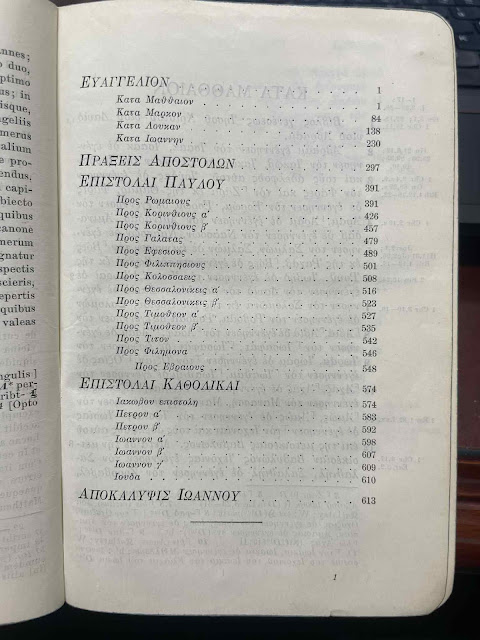Here’s something I never noticed before. The order of books in Nestle’s 1st ed. (1898) follows Luther’s 1522 NT. Here you can see the two side-by-side. What makes the Nestle odd in a way even Luther’s is not is the headings. I may be wrong, but I can’t remember Hebrews ever being included with the Catholic Letters in any manuscript.
 |
 |
| Luther Bible (1522) | Nestle 1 (1898) |
By the third edition (1901) the books were back in their Erasmian order, although Hebrews was still set off just slightly from the other Pauline letters. You can see it here in my copy of the 13th edition which is the same.
 |
| Nestle 13 reflecting the changed book order |
It’s worth mentioning this because my understanding is that the NA29 will switch the order of books, placing the Catholic Epistles immediately after Acts. As a result, the NA will match one of its original three sources and the one that Nestle himself called “the one constituent factor” in his edition (=WH).
Minor update: I notice the Nestle 13th ed. (1927) has the following note at the bottom of the page of Rom 1: “HTWS [=WH, Tischendorf, Weiss, and von Soden] Epistolas Catholicas (Jc, 1.2 P, 1-3 J, Jd) Paulinis anteponunt; epistolam ad Hebraeos datam epistolis pastoralibus praemittunt.”
P.S. Did you know you can look at scans of all the Nestle/Nestle-Aland editions in the VMR? In the Manuscript Workspace, search for N1, N2, etc. in the Manuscripts tab search box. From the 22nd ed. on, search for NA22, etc.

Was this order of books standard in all editions of the Luther Bible up through Nestle's day? If so, then he was probably following the precedent of what he, being German, knew as the standard order of books.
ReplyDeleteIt is an interesting, and unfortunate, decision on both Luther's and Nestle's parts though, regardless of their reasons.
I also had this question but I don’t know the answer.
DeleteIn answer to the question, Hebrews James Jude Revelation at the end of the NT does appear to be the standard order of books in editions right up through Nestle's day. E.g.:
Delete1522 - https://archive.org/details/1522-luther-nt/page/n13/mode/2up
1776 - https://archive.org/details/bim_eighteenth-century_biblia-_bible-german-luther_1776/page/n3/mode/2up
1837 - https://archive.org/details/DEUL45_DBS_HS/German-%281837%29-Luther-Bible-Die-Bibel-oder-Die-ganze-Heilige-Schrift-des-Alten-und-Neuen-Testaments/page/n829/mode/2up
1883 reprint of 1522 - https://archive.org/details/DEUL45_DBS_HS/German-%281522%29-Luther-New-Testament-%28Das-Newe-Testament-Deutzsch%29-reprint/page/n19/mode/2up
1903 reprint of 1545 - https://archive.org/details/LutherBibleCPH1903/page/n4/mode/1up
Perhaps as non-German readers began to pick up Nestle Snr's work, the Erasmian book order became more appropriate? The first German Protestant Church revision to the Lutherbibel was in 1892 (https://www.die-bibel.de/lutherbibel), so could be interesting to see if the book order changed then, or in subsequent revisions.
What is wrong with putting the books in their normal order, and including a chronological page or whatever? Must we always be innovating Athenians?
ReplyDeleteWhat would be the "normal order"?
DeleteThe order in our printed Bibles.
DeleteThe 'normal order' in your printed bible is an innovation.
DeleteIt’s been an innovstion for a considerablly long time, and it is well-known!
DeleteThe Lutheran tradition often takes into account the distinction between homologoumena and antilegomena in the NT. So, it's not entirely surprising that Luther himself would have this list of several disputed books set off from the rest at the end. Especially as he himself disputed their canonicity at one time or another. I don't know that that's the reason, but I think it's plausible.
ReplyDeleteYes, that’s the reason Luther did. He had questions about all 4 of those books. But I’m surprised to see a Greek New Testament c. 375 years later follow his example.
DeleteYeah, that's really interesting.
DeleteThe question of the order of books in N1 is well known and is clearly described by H.J. de Jonge in note 83 on p. 182 in this article: https://www.brepolsonline.net/doi/abs/10.1484/M.LECTIO-EB.5.121280 :
ReplyDelete83. In Nestle's first German-Greek edition (1898) and in his first and second Greek editions (1898, 1899), the order was that of Luther's New Testament, determined by the order of the German text in the first bilingual edition, which was published in the same year (1898) as, but earlier then, the first Greek edition: Gospels-Acts-Paul's Epistles through Tit. and Philem.-I-II Petr.-I-II-III Ioh.-Hebr.-Iac.-Iudas-Apoc.
Thanks, Teunis. I think I read that a few years ago but had forgotten.
DeleteWill someone please kindly explain the real reason for the changing of the order of the NT books. I understand this issue of making the order follow the order of the books in early manuscripts. However, we live in the 21st century. It seems like a few people are wanting to make the rest of the Bible reading world comply.
ReplyDeleteNo publishing house is going to produce an English or Spanish (or any other modern language) translation of the Bible following this new order. Why? Because no one will buy it. This is the same reason why, even though greater than 90% of all biblical scholars agree that the PA should not be included in Scripture, it is still being printed in the text. Why? Because no one will buy a translation without it (or very few people).
Even current scholars will have to be constantly think about which edition of the GNT that they have picked up (or viewing online) in order to find their passage. I probably have over 20 editions of the GNT. But when I pick up these newer editions, I will have to hunt for my passage. Please help me understand. Thank you.